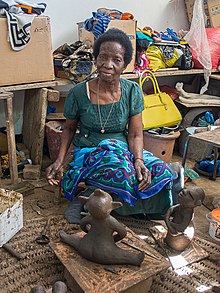| Wamakonde | |
|---|---|
 A makonde artist, Reinata Sadimba,showcasing Makonde artwork at a museum in Maputo, Mozambique A makonde artist, Reinata Sadimba,showcasing Makonde artwork at a museum in Maputo, Mozambique | |
| Regions with significant populations | |
| 1,200,000 | |
| 240,000 | |
| 3,764 | |
| 1,400 | |
| Languages | |
| Kimakonde, Kiswahili, English, Portuguese, French | |
| Religion | |
| In Tanzania:
Majority Islam Minority Ancestor Worship In Mozambique: Majority Christianity | |
| Related ethnic groups | |
| Yao,Mwani,Makwe and Other Bantu peoples | |
| Person | Mmakonde |
|---|---|
| People | Wamakonde |
| Language | Kimakonde |
| Country | Umakonde |
The Makonde are an ethnic group in southeast Tanzania, northern Mozambique, and Kenya. The Makonde developed their culture on the Mueda Plateau in Mozambique. At present they live throughout Tanzania and Mozambique, and have a small presence in Kenya. The Makonde population in Tanzania was estimated in 2001 to be 1,140,000, and the 1997 census in Mozambique put the Makonde population in that country at 233,358, for an estimated total of 1,373,358. The ethnic group is roughly divided by the Ruvuma River; members of the group in Tanzania are referred to as the Makonde, and those in Mozambique as the Maconde. The two groups have developed separate languages over time but share a common origin and culture.
History

The Makonde successfully resisted predation by African, Arab, and European slavers. They did not fall under colonial power until the 1920s. During the 1960s the revolution which drove the Portuguese out of Mozambique was launched from the Makonde homeland of the Mueda Plateau. For a time the revolutionary movement FRELIMO derived some of its financial support from the sale of Makonde carvings, and the group became the backbone of the revolutionary movement. The Maconde of Mozambique, due to their role in the resistance to Portuguese colonial rule, remain an influential group in the politics of the country.
They speak Makonde, also known as ChiMakonde, a Bantu language closely related to Yao. Many speak other languages such as English in Tanzania, Portuguese in Mozambique, and Swahili and Makua in both countries. The Makonde are traditionally a matrilineal society where children and inheritances belong to women, and husbands move into the village of their wives. Their traditional religion is an animistic form of ancestor worship and still continues, although Makonde of Tanzania are nominally Muslim and those of Mozambique are Catholic or Muslim. In Makonde rituals, when a girl becomes a woman, Muidini is the best dancer out of the group of girls undergoing the rituals.
The Makonde are best known for their wood carvings, primarily made of blackwood (Dalbergia melanoxylon, or mpingo), and their observances of puberty rites.
Kenyan citizenship
Some Makonde people from Mozambique had relocated to Kenya in the 1950s. Early in the 21st century efforts began to obtain Kenyan identity cards to allow the Makonde to exercise their rights and privileges as Kenyan citizens. In 2016, a group of 300 Makonde people trekked from Kwale to Nairobi. The group was led by Diana Gichengo an inclusions activist and accompanied by other human rights supportive stakeholders. They headed to the State House in Nairobi to persuade the President to push their recognition as Kenyan citizens. President Kenyatta gave them a warm welcome. After a well-prepared meal on Thursday 13 October 2016, the President ordered the relevant ministry to provide the Makonde with identity cards by December 2016.
Makonde art

The Makonde traditionally have carved wooden household objects, figures and masks for ritual use. After the 1930s, Makonde art has become an important part of the contemporary art of Africa. The most internationally acknowledged such artist was George Lilanga.
Notable Makonde people
- Benjamin Mkapa, third President of Tanzania
- George Lilanga, Tanzanian artist
- Filipe Nyusi, fourth President of Mozambique
- Major General Makame Nnalihinga Rashid, former Chief of National Service, Tanzania
- Reinata Sadimba, Mozambican artist
- Harmonize (Rajab Abdul Kahali), a famous musician from Tanzania. Founder of Kondegang
- Jaymoe (Juma Mohamed Mchopanga), Tanzanian hip hop artist.
References
- ^ John Ndembwike (October 2009). Tanzania: Profile of a Nation. Intercontinental Books. pp. 149–. ISBN 978-9987-9308-1-4.
- "2019 Kenya Population and Housing Census Volume IV: Distribution of Population by Socio-Economic Characteristics". Kenya National Bureau of Statistics. Retrieved 24 March 2020.
- PeopleGroups.org. "PeopleGroups.org - Makonde of Mayotte". peoplegroups.org. Retrieved 2021-08-26.
- ^ Sousa., Santos, Ana Margarida (2011). History, memory and violence : changing patterns of group relationship in Mocimboa da Praia, Mozambique (PDF). Oxford University.
{{cite book}}: CS1 maint: multiple names: authors list (link) - Service, Islington Education Library (2003). "Makonde 'Tree Of Life' Carving, Tanzania | Object Lessons - Ceremony & Celebration: Family & Culture". Islington Education Library Service. Retrieved 2021-08-26.
- Service, Islington Education Library (2003). "Makonde 'Tree Of Life' Carving, Tanzania | Object Lessons - Ceremony & Celebration: Family & Culture". Islington Education Library Service. Retrieved 2021-08-26.
- ^ Makone People & Citizenship UNHCR
- ^ Appiah, Kwame Anthony; Gates, Henry Louis, eds. (2010). Encyclopedia of Africa. Vol. 2. Oxford New York: Oxford University Press. p. 115. ISBN 9780195337709.
- ^ Twelve African Languages - Makonde Dimmendaal, G, J. 2009. Coding Participant Marking: Construction Types in Twelve African Languages. John Benjamins Publishing. p281.
- Service, Islington Education Library (2003). "Makonde 'Tree Of Life' Carving, Tanzania | Object Lessons - Ceremony & Celebration: Family & Culture". Islington Education Library Service. Retrieved 2021-08-26.
- ^ Makonde People Become 43rd Kenyan Tribe News from Africa, 14/10/16, Retrieved 12/04/18
- Mohl, M.: Masterpieces of the Makonde (1990)
- David Lawrence (12 March 2009). Tanzania and Its People. Intercontinental Books. pp. 41–. ISBN 978-1-4414-8692-9.
- https://www.boomplay.com/share/artist/6764334
Further reading
- John Stoner (1998). Makonde. The Rosen Publishing Group. p. 1. ISBN 978-0-8239-2016-7.
External links
| Ethnic groups in Mozambique | |
|---|---|